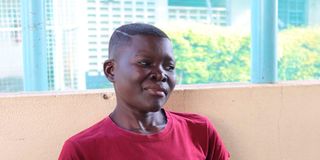Fear of HIV infection, default from treatment derail war on TB

Linda Awuor during the interview at her home in Karachuonyo, Homa Bay County on June 21. She was diagnosed with TB in March.
What you need to know:
- According to Kenya Population-based HIV Impact Assessment (Kenphia), 2018, HIV prevalence in Homa Bay is 19.6 per cent, down from 26 per cent in 2013. The high prevalence has been identified as the major cause of the surge in TB cases.
- Further statistics have showed that for every 100,000 individuals, 187 suffer from TB. The patients may have either been diagnosed or are unaware of their status.
When Linda Awuor, 26, started having constant headaches and heavy sweating at night, she rushed to the nearest chemist in search of anti-malarial drugs.
Prior to that, Linda, who worked as a house help, would display signs of fatigue and painful joints and could hardly eat. Having suspected a case of malaria, she visited a trading centre in Karachuonyo, Homa Bay County, and left with a full prescription.
But the symptoms persisted and barely two weeks after clearing her medication, she had lost 30 kilogrammes and could not walk around without support. “Those around me suspected I could have contracted HIV/Aids, forcing me to travel home for further medication.”
Her health kept deteriorating in the following weeks and on March 20, 2022, she visited Homa Bay Referral Hospital for treatment, weighing 36kg, down from 72kg. “I had to go through a series of tests before I was diagnosed with Tuberculosis (TB) and immediately placed on medication.”
Barely three months later, her health has greatly improved and she has gained 24kg. She says the mild side effects of the TB drug, including swollen legs, hands and pain on her back, are manageable.
Linda is among hundreds of TB patients in Homa Bay County who, because of a number of challenges, often fail to visit health facilities early enough for treatment.
According to County TB and Leprosy Coordinator Caroli Migwambo, high HIV prevalence makes a number of patients shun health facilities for fear that they might have contracted the virus.
“A number of patients often visit health facilities when already overwhelmed or when symptoms persist and are in advanced stages,” says Caroli .
He expresses concern that some patients, especially those in the hilly places like Suba sub-county, are at risk of succumbing to the illness because of transport challenges, citing poor access roads to health facilities. The situation is not any different on the islands, where locals have to travel to health centres on canoes.
According to Kenya Population-based HIV Impact Assessment (Kenphia), 2018, HIV prevalence in the county is 19.6 per cent, down from 26 per cent in 2013. The high prevalence has been identified as the major cause of the surge in TB cases.
Further statistics have showed that for every 100,000 individuals, 187 suffer from TB. The patients may have either been diagnosed or are unaware of their status.
Caroli notes that over 30 per cent of the total deaths in the county are due to TB, which often ruins the lungs, abdomen, glands, bones and the nervous system. He also raises concerns about the growing number of drug-resistant TB due to medication default.
“Fishermen are the majority of patients who default on their medication. A number of the fishermen move to different locations from time to time in search of fish, hence tracing them is a major challenge," he says.
The most affected areas are Remba, Takawiri, Ringiti, Ngodhe and Mfangano islands of Lake Victoria. They account for 40 per cent of the missing TB patients. One risk of defaulting is developing drug-resistant TB that takes up to 24 months to treat.
The county has rolled out a programme in partnership with non-governmental organisations to accelerate early screening and awareness targeting TB and HIV-positive patients.
The Centre of Health Solutions (CHS) is among organisations working towards reducing TB through early screening. It offers health education and mentorship to medical experts, who, in turn, visit individuals while raising awareness.
Health experts visit individuals at their homes offering mobile TB screening and X-rays services and diagnosing and treating patients. CHS transports test samples to the nearest health centre and results are delivered to the patients on time.
Kennedy Korir, Suba sub-county TB and Leprosy coordinator, says they focus on marginalised areas with limited access to health facilities. He accesses a number of remote areas on a motorbike, collecting samples and delivering them to the nearest centres for prompt treatment where necessary.
"We also partner with beach management unit officials and community health volunteers to trace patients who disappear on the lake. We also have more than 24 sites around the islands offering TB and HIV services," he says.
Stella Omullo, CHS Nyanza regional TB accelerated response and care officer, says their partnership with the national government has seen the number of cases drop. She says the team constantly collects test samples while sensitising individuals on the importance of early screening.
In 2021, Homa Bay was recognised as one of the counties with successful TB management after Laikipia and Migori, thanks to the programmes.
Caroli says deaths due to TB have reduced to five per cent, up from seven per cent two years ago, courtesy of the efforts by healthcare workers towards eliminating the disease by 2035, in line with the Health ministry goal.
"Our major challenge is that at five per cent, death rates are still high, but we hope the numbers will keep reducing,” says Stella.






